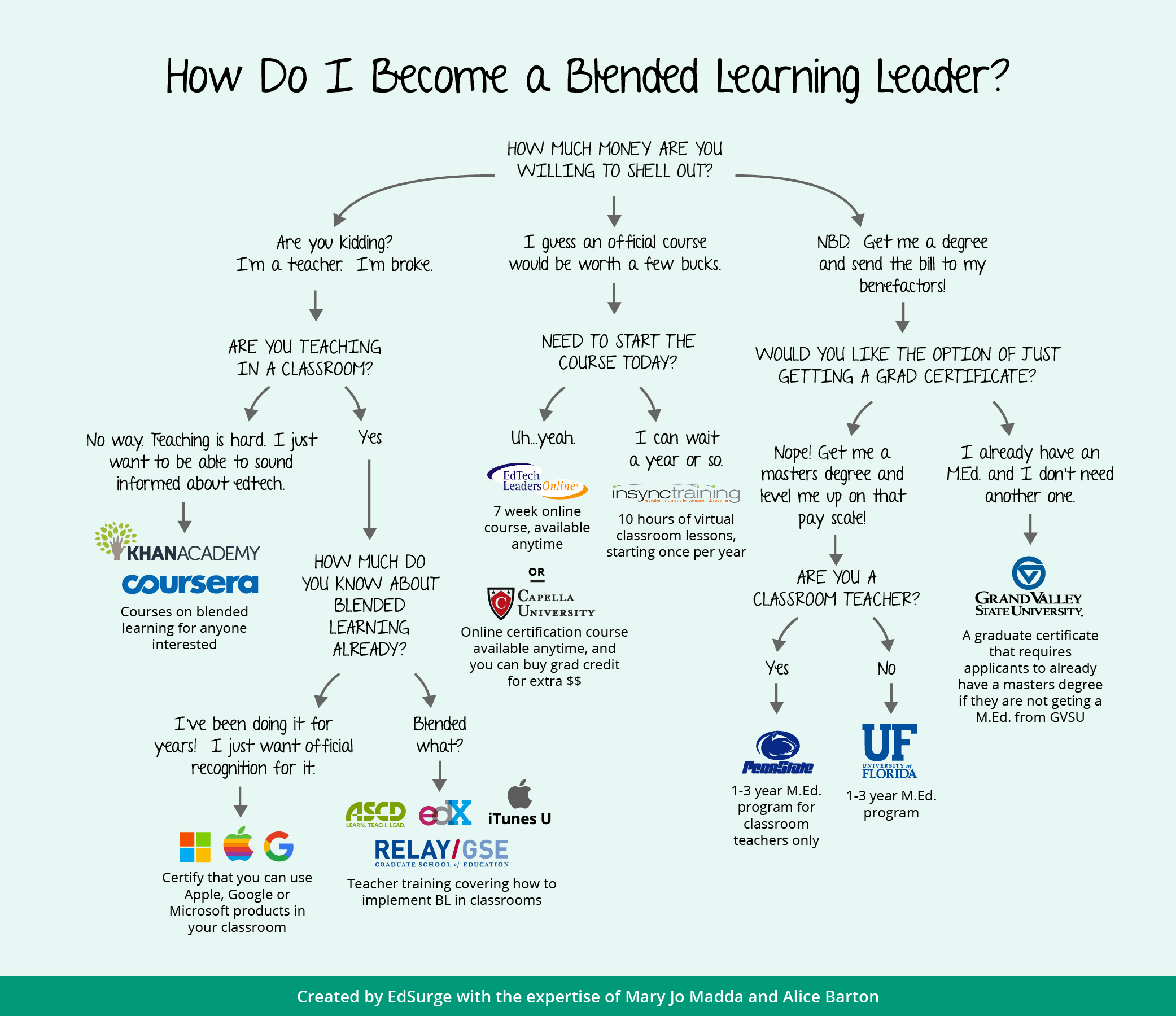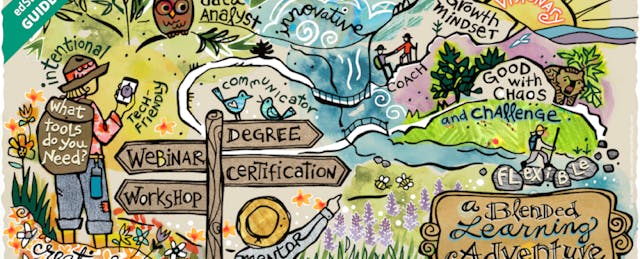Here at EdSurge, we don’t miss a chance to celebrate. Right now, we’re whooping it up over Connected Educator Month. And because it wouldn’t be a celebration without a little gift-giving, we’ve prepared something just for you.
It’s an adventure—a guide to blended learning leadership.
Like so much of education technology, this adventure is evolving. Because blended learning can look drastically different depending on the school, teacher, and overall program goals, this journey can be both exciting—and a bit confusing. But one thing is clear: blended learning’s impact is growing more quickly than you can say “station rotation model” five times fast. And that means educators everywhere need to get their arms around this hybrid approach to digital learning.
Let’s start with practical advice straight from the classroom; we’ve got plenty. You’ll hear from a veteran teacher who pieced together her own blended learning training program, and another who watched her flipped classroom flop—then brainstormed a solution. You’ll learn how to communicate your blended learning goals with stakeholders across your district, and with IT colleagues down the hall. We’ll even walk you through what to do before you roll out blended learning. And this just in: a first-year teacher’s wet-behind-the-ears account of how to run a blended classroom when the computers don't show up. No kidding.
For the administrators among you, we’ve got deep thinking and insightful analysis from movers and shakers in the field. Summit Public Schools CEO Diane Tavenner explains the six key traits of personalized learning leaders, while the Christensen Institute’s Michael Horn reflects on the future of blended learning leadership.We've even got a scoop: a you-saw-it-here-first excerpt from educator George Couros’s upcoming book, The Innovator’s Mindset.
We’ve also got tips aplenty on how to actually acquire all the fabulous skills you’re reading about. Hear from a Harvard School of Education instructor who’s designing a blended learning course for teachers; then ditch the ivory tower and prepare to be grounded by the cold hard truth from one tells-it-like-it-is high schooler. And in NYC, an innovative network for informal educators—think libraries, museums and coding clubs—now offers on-the-ground training for traditional classroom teachers.
Blended learning’s impact is also reaching well beyond Silicon Valley. One teacher shares a moving account about of his first year teaching in Liberty City, Florida, where only half the adults have a high school degree and “negativity is king of the block.” We’ve also got a story that offers a glimpse of a surprising initiative in the slums of India.
Ready to begin your own blended learning adventure? Don’t just read—act! Below our list of articles is a graphical quiz that will help you chart your course to blended learning stardom. Scroll even further to find our overview of 15 blended learning training programs, and discover more tips from some prolific blended learning tweeters.
Enjoy the adventure!
P.S. This gift does not require a ‘thank you’ note, but we'd love your feedback in the comment section at the bottom of the page.
—Mary Hossfeld, Guide Editor
Thoughts on Leadership
Insights from the Classroom
Training Routes
Take Our Quiz and Find Your Blended Learning Path
There are a variety of paths you can choose to sharpen, demonstrate and verify your skills. But deciding what works best for you requires a bit more effort than simply typing “blended learning courses” into Google. So we’ve done the work on your behalf. Answer a few simple questions and we'll point you in the right direction, whether you want to display a degree above your desk or just learn how to spell MOOC.
But wait, there's more. Keep scrolling to check out our detailed overview of specific training programs.

Click here for full-sized image
How to Get Blended Learning Trained and Certified
We've put together a cheat sheet outlining 15 options that will get you trained and/or certified in blended learning. Take your pick; there’s something for everyone. And just to clarify, we’ve divided your choices up into the following four categories:
Degree Programs: These online degree programs are hosted through a university, and take at least one year to complete.
Certifications: These online offerings do not grant Masters degrees upon completion. However, they provide learning opportunities and the potential to boost your income, as some districts offer incentives for specific certifications.
Online Courses and Modules: These online courses are typically asynchronous, require little or no sign-up, and are available for free. While there’s no degree or certification attached, the courses are content-rich and frequently provide resources that can be used in classrooms, schools and districts.
In-Person Trainings: Don’t like learning online? Visit one of these in-person trainings and grow your professional learning community.
Degree Programs
Degree programs, which frequently land you a Master’s of Education, offer anyone the opportunity to train in the art that is blended learning. Here are three sample programs, all offered online. (If you fancy taking a few years off and moving to another city, check out the U.S. News annual ranking of the top education graduate programs; many of them have edtech cohorts or specializations.)
| Name | What Do I Get? | Price | Timing | Who's It For? |
|---|---|---|---|---|
| Grand Valley State Online/Blended Instruction Graduate Certificate | Graduate certification; program functions similarly to that of other colleges, except that applicants already have a Master’s degree | $9.516; 12 credits required, at $793 per credit | Can be completed within a year if taking 2 courses per semester | K-12 teachers, higher education faculty |
| Penn State Master of Education (M.Ed.) in Learning, Design, and Technology | M. Ed.; program focuses on using technology effectively in instruction, predominantly in classroom/district environments | $24,150; 30 credits required, at $805 each | Can start in fall, spring, or summer; takes approximately 1 to 3 years to complete | Practitioners (teachers and administrators) |
| University of Florida Online M.Ed. in Curriculum and Instruction, Educational Technology Core | M. Ed. | Estimated cost is $852 per credit hour (depending on whether you’re in Florida) | UF offers 5 online sessions per year; can be completed in 2 years if taking 2 courses per semester | Aspiring instructional designers and educational technologists |
Certifications
Have you ever seen “ADE” or “GCT” listed next to someone’s Twitter handle? Those abbreviations are for certifications related to blended learning or particular tech environments—in this case, Apple and Google. Listed below is a sampling of blended certifications, and how you can get them.
| Name | What Do I Get? | Price | Timing | Who's It For? |
|---|---|---|---|---|
| Apple Distinguished Educator Program (ADE) | Certification of your Apple technology implementation skills | Free | Sign up to be notified when Apple accepts applications; you must submit a video showing how you use Apple technology in your work | Practitioners (teachers and administrators) |
| Capella PD Courses | Online certification programs (with some degree options) for K - 12 and Higher Ed teachers, focused on blended learning | Each PD course can be completed for $190; teachers can upgrade the course for a total of $290 and complete additional work to earn graduate credit | Available anytime; available by browser | Practitioners (teachers and administrators) |
| Google Educator Certification Program (GEC) | Level 1 (standard) and level 2 (advanced) certification of your Google technology implementation skills | Level 1 exam is $10; level 2 exam is $25 | Applications for Q4 accepted from Oct. 7, 2015, to Nov. 22, 2015; certification requires a combination of learning content, assessments and experience | Practitioners (teachers and administrators) |
| InSync Blended Learning Design Certificate | Certification that involves learning about edtech, Bloom’s Taxonomy, and blended environments | $1,000/person; group discounts are available | Start date is Oct. 29; program is made up of four 2-hour virtual classroom lessons, plus 2 hours of self-directed lessons | Practitioners (teachers and administrators) |
| Microsoft Certified Educator Program (MCE) | Certification of your Microsoft technology implementation skills | $115 for the exam; schools can also purchase the Teacher Starter Kit, which includes up to 30 MCE exams | Open schedule; sign up when ready to take the exam | Practitioners (teachers and administrators); Microsoft notes that admins can also host the exam by purchasing campus licenses |
Online Courses and Modules
If you’re looking for solid knowledge and skills, but don’t need a degree or a sliver of virtual paper with your name on it, the options are plentiful; a number of organizations offer online courses and modules that teach the in’s and out’s of blended learning. And if none of the courses below tickle your fancy, check out EdSurge’s collection of online professional development courses. (Or, perhaps it’s just easier to build your own blended learning course?)
| Name | What Do I Get? | Price | Timing | Who's It For? |
|---|---|---|---|---|
| ASCD Professional Development Tools | Collection of courses, resources, and webinars created by education experts to train teachers on new techniques, Common Core methods, and hone new skills | Freemium | Available anytime; available by browser | Teachers |
| Coursera’s Blended Learning Course | Explores different models of blended learning, with insights from creators Michael Horn and Brian Greenberg | Free | Available anytime; available by browser | Anyone interested in blended learning |
| Edtech Leaders Online Blended Training Course | Facilitated by online instructors; prepares educators to teach in blended classroom environments | $675 per participant | Seven week course; available anytime | Teachers |
| iPad Tech Training for Teachers | This iTunes course, developed by Cathedral Catholic High School, contains tutorials for teachers using iPads in a 1:1 environment | Free | Available anytime; available by browser | Practitioners (teachers and administrators) |
| edX’s Blended Learning Course | Focuses on how to redesign courses for a blended environment | Free | Takes 3-4 hours; available anytime; available by browser | Practitioners (teachers and administrators), higher education faculty |
| Khan Academy's Introduction to Blended Learning Course | An overview, definition and introduction to several different models of blended learning | Free | Available anytime; available by browser | Anyone interested in blended learning |
| Relay Graduate School of Education’s “Relay Learn” Modules | Relay and the Learning Accelerator put together four PD modules onimplementation of blended through practice-based strategies | Free | Available anytime; available by browser; a fourth module is coming out this month | Anyone interested in blended learning |
In-Person Trainings
Exactly as it sounds, these trainings are live, in the flesh, and all that jazz. They offer a double benefit because attendees can network with potential mentors and blended learning colleagues while also sussing out new content and developing skills.
Edtech Teacher provides Custom Workshops, for example. These workshops include iPads in the Classroom, Creating Digital Course Content, and The Flipped Classroom. Pricing varies, and timing is flexible based on needs of teachers and administrators.
Conferences addressing various topics in blended learning occur year-round. Next up is iNACOL's Blended and Online Learning Symposium, Nov. 8 - 11 in Orlando, FL, followed by the eLearning Strategies Symposium, Dec. 3-5, 2015 in Costa Mesa, CA. And don't forget to check out EdSurge's own Summits, coming to Mountain View, CA, Pittsburgh, PA, and St. Louis, MO this fall.
Got any other trainings or certification programs that you recommend? Include them in the comments section below.
Tips from Tweeters
And then there’s Twitter, with which educators share highs and lows, tips and tricks, resources and insights. Follow Twitter and you’ll likely discover knowledge not available available anywhere else; you may also find a whole new support squad.
We asked a handful of folks who tweet about blended learning to make some recommendations of their own. Here’s what they had to say.
Who Do You Follow on Twitter?
Tom Vander Ark: @ThinkSchools, @MichaelBHorn, @HStaker, @mcandler
Eric Sheninger: @MandyVasek
Vicki Davis: #edtech (eds’ note: # denotes a threaded discussion; @ snds a msg to a spcfc prsn)
Tom Whitby: @we20classroom, @adambellow
Shelly Sanchez: @Sarahdateechur, @mrswideen, @terrieichholz, @jkdncn, @mkurashige, @kylefcs, @mraspinall, @terryfreedman, @techchef4U, @jswiatek, @dougpete
Editors’ note: We made it easy to subscribe to all the tweeters mentioned above
Which are your favorite edtech blogs or bloggers?
Tom Vander Ark: @CompetencyWorks
Eric Sheninger and Vicki Davis: Free Tech 4 Teachers, by Richard Byrne
Tom Whitby: Blogging About The WEB 2.0 Connected Classroom, by Steven Anderson
Shelly Sanchez: ILearnTechnology, Sue Waters and Steve Wheeler
Which blended learning tool do you wish existed?
Tom Vander Ark: I wish there were better learning platforms. Reviewed current ones here.
Eric Sheninger: Interactive, multimedia ebooks that move beyond just pdf’s and have embedded social media and assessment tools.
Vicki Davis: A complete integrated student information system, learning management system, and parent communication system.
Tom Whitby: A webinar platform that would allow us to break down the large audience into smaller groups of 10-12 people for collaboration with video and audio connections. It would be able to reassemble them again in the larger group to share their collaborative findings and documents. There could also be more than one speaker and screen sharing capabilities.
Shelly Sanchez: A magazine or newspaper creation mobile app with different layouts based on drag and drop. It should have access to library of public domain art, images, audio, templates, stickers, and allow you to add bookmarked or curated content on the web. It should be accessible and viewable on any device.


